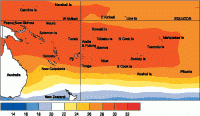Climate developments in April 2006

The "double ITCZ" structure, usually seen only in La Niña conditions, persisted in April. One region lay north of the equator from the area north of Papua New Guinea extending east across much of the Pacific. Another region extended east, south of the equator, from about Tokelau towards the Marquesas Islands. The SPCZ was displaced much further southwest than average, extending from the Coral Sea southeast toward New Caledonia. This pattern was similar to that of March, with enhanced convection and/or above average rainfall over Papua New Guinea, the northeastern seaboard of Australia, the northwest of the Solomon Islands, and some areas of New Caledonia, the Northern Cook Islands, and the Marquesas Islands.
Rainfall was at least 150% of average in Niue and much of northern New Zealand. Mixed rainfall anomalies occurred in New Caledonia, Tonga, and French Polynesia.
A region of suppressed convection affected Nauru, Western and Eastern Kiribati, extending to Tuvalu, Vanuatu, Fiji, Southern Tonga, Niue, the Southern Cook Islands, the Society Islands, and Pitcairn Island, with below average rainfall in many areas.
Mean air temperatures were at least 1.0 °C above average in parts of New Caledonia, and more than 1.5 °C above average in parts of Tonga.
Southwest Pacific mean sea-level pressures were above average south of the Cook Islands, and below average over northern French Polynesia. Equatorial surface easterlies continued to be very persistent along the equator, occurring in 99% of observations at Tarawa.
| Country | Location | Mean Air Temp. °C | Dep. from average | Comments |
|---|---|---|---|---|
| New Caledonia | La Tontouta | 25.5 | +1.3 | Well above average |
| New Caledonia | Noumea | 25.7 | +1.2 | Well above average |
| New Caledonia | Moue | 25.1 | +1.1 | Well above average |
| Tonga | Ha’apai | 27.8 | +1.6 | Extremely high |
| Tonga | Fua’amotu Airport | 26.9 | +1.6 | Record high |
Soil moisture in April 2006

Estimates of soil moisture shown in the map (above) are based on monthly rainfall for one station in each country. Currently there are not many sites in the water balance model. It is planned to include more stations in the future.
The information displayed is based on a simple water balance technique to determine soil moisture levels. Addition of moisture to available water already in the soil occurs by rainfall with losses via evapotranspiration. Monthly rainfall and evapotranspiration is used to determine the soil moisture level and its changes.
Please note that these soil moisture calculations are made at the end of the month. For practical purposes, generalisations were made about the available water capacity of the soils at each site.
At the end of April, all sites – Tarawa, Nadi, Apia, Nuku'alofa, Hanan, and Rarotonga in the water balance model were at full soil moisture capacity. All sites had similar soil conditions at the same time last year. Data are not available to show conditions for the same time last year for Apia and Tarawa.
El Niño/Southern Oscillation (ENSO)


The tropical Pacific has returned to a neutral state, although it still exhibits some weak La Niña anomalies. Equatorial Pacific sea surface temperature (SST) anomalies are close to zero, except near South America where cool anomalies have emerged.
For April, the NINO3 SST anomaly was around +0.3 °C (-0.1 °C for February-April) and NINO4 was near 0.0 °C (-0.4 °C for February-April). The region of negative subsurface temperature anomaly in the eastern Equatorial Pacific has contracted and all but disappeared. There is a small cold pool near 110 °W (1 °C below average).
Conversely, the Southern Oscillation Index (SOI) was +1.7 for April and the February-April 3-month mean was +0.9. Stronger than normal easterly winds occurred west of the Date Line, and patterns of convection in April remained consistent with La Niña conditions. The NASA ENSO precipitation index for April was -1.2 (negative values are indicative of La Niña). Convection in April was strongly enhanced over Indonesia and northern Australia (with tropical cyclone activity near Darwin), and the SPCZ shows a southwards displacement. Convection was suppressed near the Date Line and the "double ITCZ" persisted between the Date Line and 90 °W. The Madden-Julian Oscillation showed renewed activity during the first week of April, but then weakened.
All ENSO forecast models are in the neutral range for May-July 2006. The Scripps model is forecasting the previously cold conditions to be replaced by mild warm conditions (weak El Niño) by the end of 2006. The International Research Institute for Climate and Society (IRI) April summary gives a 75% chance of neutral conditions through June.
Tropical cyclones
There have been eight tropical cyclones to date in the Southwest Pacific (including the region west of latitude 150°E). The most severe tropical cyclone this season occurred over 17-24 April. 'Monica' originated south of Papua New Guinea, and tracked west over Australia’s Cape York Peninsula, over the Gulf of Carpentaria, and toward Darwin. 'Monica' was one of the most intense tropical cyclones ever seen in Australia waters, and strongest on record to affect Australia’s Northern Territory, with estimated maximum sustained wind speeds reaching 250-290 km/h, with gusts to 350 km/h.
Please visit www.bom.gov.au/announcements/sevwx/nt/nttc20060417.shtml for more detail on Tropical Cyclone Monica.
In the Southwest Pacific, there is on average less than one tropical cyclone every three years in May. The June issue of the ICU will provide a summary of the southwest Pacific 2005-06 tropical cyclone season.
